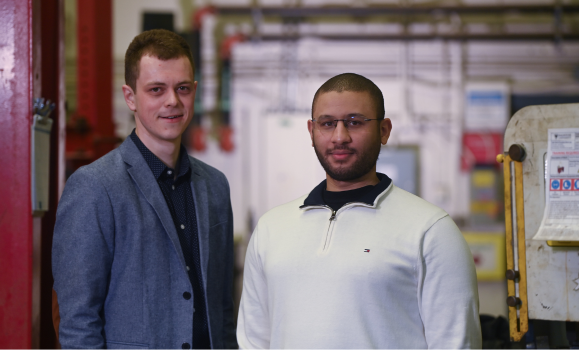News
» Go to news mainBridging Innovation – Engineering Student Partners with Industry Leader on Robust Bridge Solutions

Aging infrastructure poses numerous challenges in Canada, and bridges, as critical components of transportation networks, are no exception.
Edward Steeves realized this very early on in life. Born in a small village in New Brunswick along the Saint John River, Steeves says there were only two bridges that connected residents to the other side of the province.
“When I was a kid, there were four lanes of traffic over that body of water. Now because of the aging infrastructure, one of those bridges is closed and the other is temporarily down to one lane of traffic,” he explains. “Now we are seeing the large socioeconomic impact of what happens when we close our bridges and what kind of disruption that causes to traffic and to the local economy.”
Empowered by the experiences of his youth, the Dalhousie Masters of Structural Engineering student is now working with CBCL Limited to assess and evaluate the structural resilience of existing bridges across the Maritimes.
The initiative, a joint collaboration between the engineering and environmental consulting company and Dalhousie University’s Structural Assessment and Retrofit (SAR) research group, is an opportunity made possible through the Mitacs Accelerate Program.
 Edward Steeves (Left) and Dal PhD student Abdalla Alhashmi (right) are two students from the SAR group pursuring studies through the Mitacs Accelerate Program.
Edward Steeves (Left) and Dal PhD student Abdalla Alhashmi (right) are two students from the SAR group pursuring studies through the Mitacs Accelerate Program.
Mitacs is a Canadian non-profit organization that fosters research collaborations between academia, industry and government. The organization’s Accelerate Program provides graduate students and postdoctoral fellows with funding to not only pursue their studies, but also the opportunity to collaborate on research projects with industry partners. The program provides practical research experience to students while helping companies address specific challenges or develop new technologies.
For CBCL limited, that’s assessing the robustness of bridges across the region.
Bridging partnerships between industry and academia
What does that mean?
“A lot of bridges were built over 50 years ago, and in those days, they were often only designed for a service life of 50 years. So a lot of them have actually passed their design life now,” says Steeves. “A robust structure is one that’s able to resist damage and not collapse,” explains Steeves. “Current bridge codes require engineers to design and evaluate our bridges based on loads that are expected to occur in their design life. This includes the bridge’s capacity to withstand its own weight, loads imposed by vehicles and pedestrians, and environmental loads such as winds and earthquakes. These can lead to damages over time such as cracking or corrosion.”
“There are a lot of different ways that bridges can be damaged, but what we’re really concerned about is after those bridges have been damaged,” says Steeves. “Will that structure be able to withstand the damage or will it fail? That’s very difficult to predict.”
“Our codes provide prescriptive guidelines on how we design our bridges to resist those loads that we can expect to occur, but what’s missing are the research gaps,” he adds. “The codes provide limited guidance to help engineers assess the safety of our bridges after they’ve been subjected to some level of damage.”
As part of Dal’s SAR group, Steeves has spent the past year and a half, addressing these issues.
Under the leadership of Dalhousie Engineering professor, Dr. Fadi Oudah, the SAR group explores unique methods to assess the integrity of existing structures while pioneering state-of-the-art technologies for structural repair and enhancement. This includes developing mathematical formulas and tools to assess the robustness of structures such as bridges and applying that research to real-life case studies.
That’s where CBCL plays a pivotal role.
“We’re looking at a bridge in Nova Scotia, and then another one in rural New Brunswick to learn how robust those structures are,” says Steeves. “From there, we’ll develop some retrofitting techniques that can improve the robustness if needed so that in the event of damage, we have a structure that won’t collapse.”
With over 4,100 bridges in the Nova Scotia alone, it’s a research initiative that will have a significant impact on our region.
“I’ve always had an interest in helping other people and trying to improve the quality, health and safety of our world,” says Steeves. “When you lose a bridge, or when a bridge closes, it causes major disruptions that can really impact the economy and safety of society.”
Investing in future innovators
Grateful to have learned about a funding opportunity that has allowed him to pursue a Masters degree while working simultaneously at CBCL, Steeves says the Mitacs Accelerate Program is a “win-win situation” for both academia and industry.
“Mitacs is really a wonderful bridge between the two,” he adds. “It provides a platform for people to study science, to do research with their professor, and then apply the application in real life. But I don’t think a lot of students know about the program.”
Both Canadian and international students pursuing graduate degrees can apply to receive Mitacs funding. Facilitating partnerships between graduate students and industry partners, the program allows students to gain exposure to industry challenges while building valuable connections for their future careers.
Recent News
- Why we remember: Women in Engineering Society marks December 6 with solemn, purposeful ceremony
- Dalhousie Grad Turns Scholarship Opportunity into a Career at Irving Oil
- New Indigenous student centre opens on Dal's Sexton Campus
- Incoming Schulich Leader aims to improve lives through innovation
- Door‑in‑Door‑out: Noreen Kamal brings an engineer’s eye to stroke treatment
- Why I Do It
- Dalhousie Student Leads the Way on Planning for 2026 Atlantic Engineering Competition
- Dalhousie Rocketry Team Soars to New Heights
